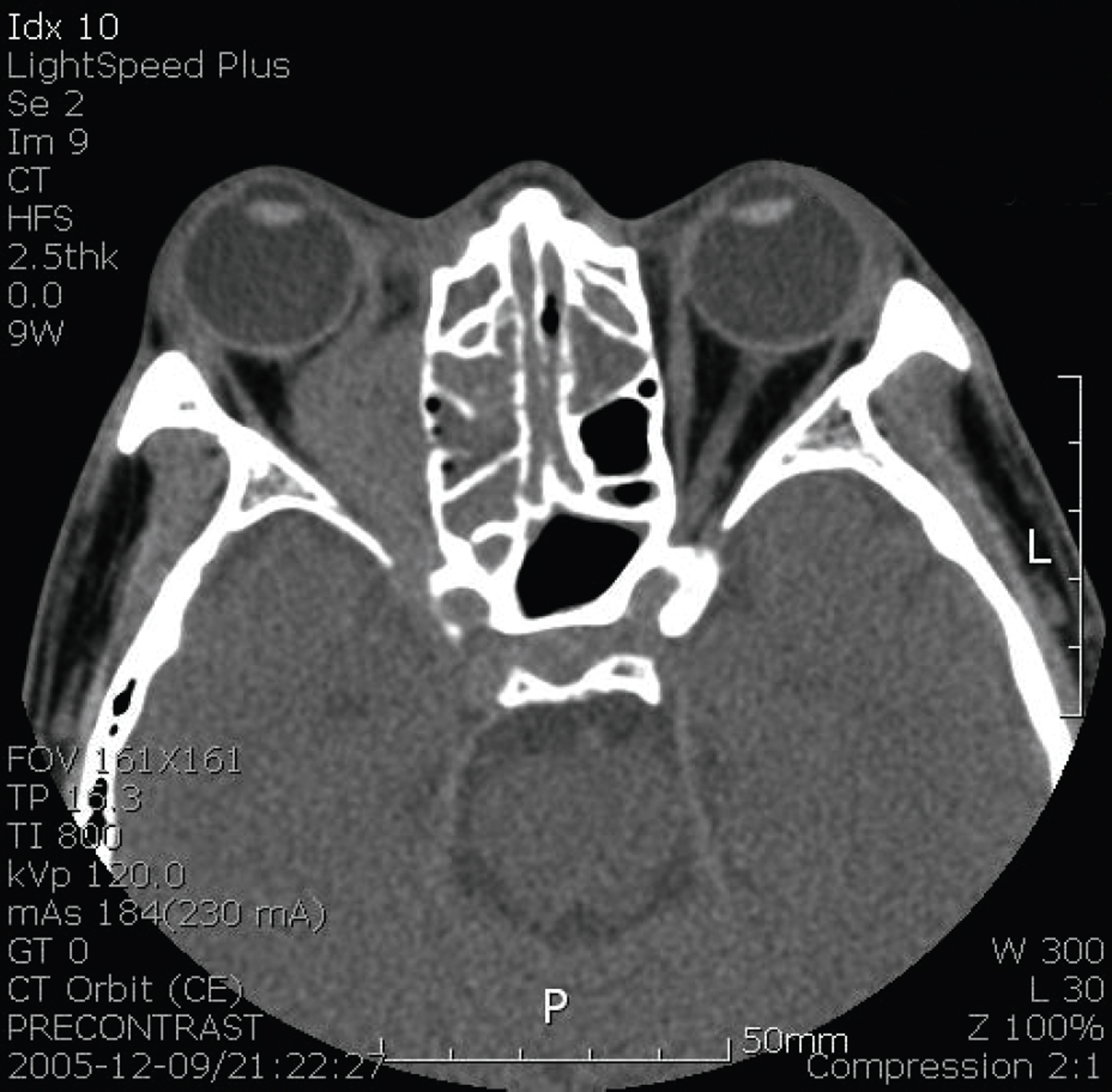J Korean Ophthalmol Soc.
2008 Sep;49(9):1543-1547.
A Case of Orbital Malignant Lymphoma associated with Acquired Immunodeficiency Syndrome (AIDS)
- Affiliations
-
- 1Department of Ophthalmology, College of Medicine, Pusan National University, Pusan, Korea. Jongsool@pusan.ac.kr
Abstract
- PURPOSE
To report a rare case of orbital malignant lymphoma that occurred in a patient with acquired immunodeficiency syndrome.
CASE SUMMARY
A 39-year-old male with acquired immunodeficiency syndrome complained of proptosis and loss of visual acuity. The best corrected visual acuity of his right eye was no light perception, and the BCVA of his left eye was 1.0. Ocular movement was limited, and esotropia of 15 prism diopters was detected. Exophthalmometry measurements showed a significant difference between both eyes (right eye was 18 mm, left eye was 15 mm). Computed tomography scans of the patient's orbit with contrast showed an enhancing mass in the right orbit, so a biopsy was performed. A biopsy specimen of the mass revealed non-Hodgkin's lymphoma (anaplastic variant, diffuse large B cell type). Distant metastasis was not found using abdominal and thoracic computed tomography and positron emission tomography. He underwent radiotherapy (30 Gy, 15 times).
CONCLUSIONS
Orbital non-Hodgkin's lymphoma (B cell type) in a patient with AIDS is rare, but our case showed a good response to radiation therapy.
MeSH Terms
Figure
Reference
-
References
1. Antle CM, White VA, Horsman DE, Rootman J. Large cell orbital lymphoma in a patient with acquired immune deficiency syndrome;case report and review. Ophthalmology. 1990; 97:1494–8.2. Brooks HL Jr, Downing J, McClure JA, Engel HM. Orbital burkitt’s lymphoma in a homosexual man with acquired immune deficiency. Arch Ophthalmol. 1984; 102:1533–7.
Article3. Ziegler JL, Drew WL, Miner RC. . The outbreak of Burkitt’s like lymphoma in homosexual men. Lancet. 1982; 2:631–3.4. Mansour AM. Orbital findings in acquired immunodeficiency syndrome. Am J Ophthalmol. 1990; 110:706–7.
Article5. Jabs DA, Green WR, Fox R. . Ocular manifestations of acquired immune deficiency syndrome. Ophthalmology. 1989; 96:1092–9.
Article6. Rosenberg SA, Diamond HD, Jaslowits B, Craver LF. Lymphosarcoma: a review of 1269 cases. Medicine. 1961; 40:31–84.
Article7. Jakobeic FA, Font RL, Orbit . Spencer WH, editor. Ophthalmic Pathology: An Atlas and Textbook. 3rd. Philadelphia: WB Saunders;1986. v. 3. chap. 12.8. Fernandez R, Mouradian J, Moore A. . Malignant lymphoma with CNS involvement in six homosexual men with AIDS. Lab Invest. 1983; 48:25.9. Reichert CM, O’Leary TJ, Levens DL. . Autopsy pathology in the acquired immune deficiency syndrome. Am J Pathol. 1983; 112:357–382.10. Lehrich JR, Hedley-Whyte T, Harris NL. Acquired immunodeficiency syndrome and cranial nerve abnormalities. N Engl J Med. 1983; 200:359–369.11. Snider WD, Simpson DM, Aronyk KE, Nielsen SL. Primary lymphoma of the nervous deficiency syndrome. N Engl J Med. 1983; 308:45.12. Shin SW, Lee SK, Kim BC. A Case of primary orbital malignant lymphoma. J Korean Ophthalmol Soc. 1995; 36:151–5.13. Kennedy RE. An evaluation of 820 orbital cases. Trans Am Ophthalmol Soc. 1984; 82:134–57.14. Uehara F, Iwakiri N, Ohba N. A twenty-year review of orbital tumor. J Eye. 1995; 12:1177–9.15. Smitt MC, Donaldson SS. Radiotherapy is successful treatment for orbital lymphoma. Int J Radiat Oncol Biol Phys. 1993; 26:59–66.
Article16. Freeman C, Berg JW, Curler SJ. Occurrence and prognosis of extranodal lymphomas. Cancer. 1972; 29:252–60.
Article17. Knowles DM, Jakobeic FA, McNally L, Burke JS. Ocular adnexal lymphoid neoplasm: clinical, histopathologic, electron microscopic, and immunologic characteristics. Hum Pathol. 1982; 13:148–62.18. Rubin P. Clinical Oncology for Medical Students and Physicians: A multidisciplinary approach. 6th. Vol. 1. New York: American cancer society;1983. p. 346–69.19. Schuman JS, Orellana J, Friedman AH, Teich SA. Acquired immunodeficiency syndrome (AIDS). Surv Ophthalmol. 1987; 31:384–410.
Article20. Cotran RS, Kumar V. Robbins’ Pathologic Basis of Disease. 6th. Vol. 1. Philiadelphia: WB Saunders;1999. p. 651–65.21. The Non-Hodgikin’s lymphoma pathologic classification project National Cancer Institute sponsored study of classifications of non Hodgikins’ lymphoma:summary and description of a working formulation for clinical usage. Cancer. 1982; 49:2112–35.22. Evans RG. Management of orbital lymphoma. Alberti WE, Sagerman RH, editors. Radiotherapy of intraocular and orbital tumor. 2nd. Berlin: Splinger;1993. v. 1. chap. 17.23. Ji JY, Ahn YC, Kim YD. Radiotherapy for malignant lymphoma of orbit and ocular adnexa. J Korean Ophthalmol Soc. 2005; 46:201–14.24. Shin SW, Lee SK, Kim BC. A Case of primary orbital malignant lymphoma. J Korean Ophthalmol Soc. 1995; 36:151–5.25. Crookes GP, Mullaney J. Lymphoid hyperplasia of the uveal tract. Am J Ophthalmol. 1967; 63:962–6.26. Bessell EM, Henk JM, Wright JE, Whitelocke RA. Orbital and conjunctival lymphoma treatment and prognosis. Radiother Oncol. 1988; 13:237–44.
Article27. Foster SC, Wilson CS, Tretler PK. Radiotherapy of primary lymphosarcoma of the orbit. Am J Roentgenol Radium Ther Nucl Med. 1971; 11:343–9.
- Full Text Links
- Actions
-
Cited
- CITED
-
- Close
- Share
- Similar articles
-
- Ocular Findings in the Acquired Immunodeficiency Syndrome
- Small Bowel Lymphoma Detected by MiroCam(R) Capsule Endoscope in a Patient with Acquired Immune Deficiency Syndrome
- A Case of Urethral Diverticulo-Rectal Fistula in Acquired Immunodeficiency Syndrome
- A Case of Jejunal Intussusception caused by Burkitt Lymphoma in an Acquired Immunodeficiency Syndrome Patient
- A Case of Molluscum Contagiosum in an AIDS Patient




